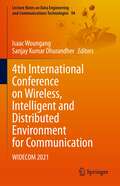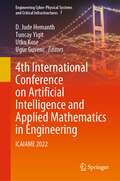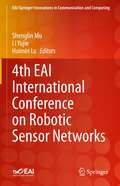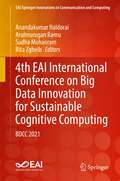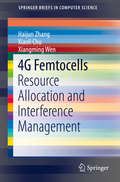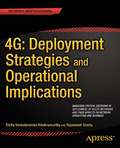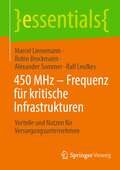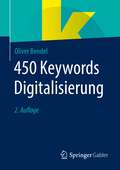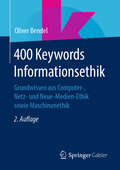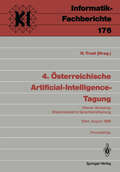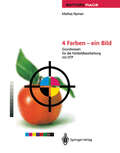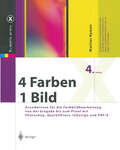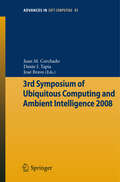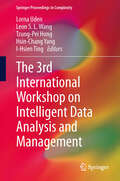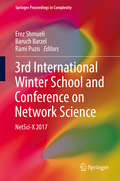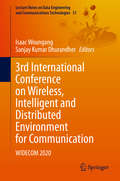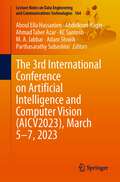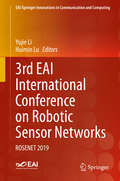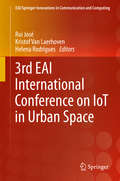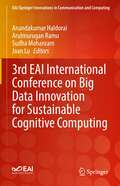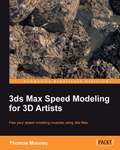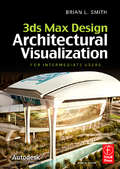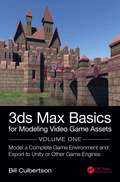- Table View
- List View
4th International Conference on Wireless, Intelligent and Distributed Environment for Communication: WIDECOM 2021 (Lecture Notes on Data Engineering and Communications Technologies #94)
by Isaac Woungang Sanjay Kumar DhurandherThis book presents the proceedings of the 4th International Conference on Wireless Intelligent and Distributed Environment for Communication (WIDECOM 2021), which took place at University of KwaZulu-Natal, South Africa, October 13-15, 2021. The book addresses issues related to new dependability paradigms, design, and performance of dependable network computing and mobile systems, as well as issues related to the security of these systems. The main tracks include infrastructure, architecture, algorithms, and protocols. The goal of the conference is to provide a forum for researchers, students, scientists and engineers working in academia and industry to share their experiences, new ideas and research results in the above-mentioned areas.
4th International Conference on Artificial Intelligence and Applied Mathematics in Engineering: ICAIAME 2022 (Engineering Cyber-Physical Systems and Critical Infrastructures #7)
by D. Jude Hemanth Tuncay Yigit Utku Kose Ugur GuvencAs general, this book is a collection of the most recent, quality research papers regarding applications of Artificial Intelligence and Applied Mathematics for engineering problems. The papers included in the book were accepted and presented in the 4th International Conference on Artificial Intelligence and Applied Mathematics in Engineering (ICAIAME 2022), which was held in Baku, Azerbaijan (Azerbaijan Technical University) between May 20 and 22, 2022. Objective of the book content is to inform the international audience about the cutting-edge, effective developments and improvements in different engineering fields. As a collection of the ICAIAME 2022 event, the book gives consideration for the results by especially intelligent system formations and the associated applications. The target audience of the book is international researchers, degree students, practitioners from industry, and experts from different engineering disciplines.
4th EAI International Conference on Robotic Sensor Networks (EAI/Springer Innovations in Communication and Computing)
by Shenglin Mu Li Yujie Huimin LuThis book presents papers presented at the 4th EAI International Conference on Robotic Sensor Networks. The conference explored the integration of networks and robotic technologies, which has become a topic of increasing interest for both researchers and developers from academic fields and industries worldwide. The authors explore how big networks are becoming the main tool for the next generation of robotic research, owing to the explosive number of networks models and the increased computational power of computers. The papers discuss how these trends significantly extend the number of potential applications for robotic technologies while also bringing new challenges to the networks’ communities. The 2nd EAI International Conference on Robotic Sensor Networks was held online on November 21-22, 2020.
4th EAI International Conference on Big Data Innovation for Sustainable Cognitive Computing: BDCC 2021 (EAI/Springer Innovations in Communication and Computing)
by Anandakumar Haldorai Arulmurugan Ramu Sudha Mohanram Rita ZgheibThis book features the proceedings of the 4th EAI International Conference on Big Data Innovation for Sustainable Cognitive Computing (BDCC 2021). The papers feature detail on cognitive computing and its self-learning systems that use data mining, pattern recognition and natural language processing (NLP) to mirror the way the human brain works. This international conference focuses on technologies from knowledge representation techniques and natural language processing algorithms to dynamic learning approaches. Topics covered include Data Science for Cognitive Analysis, Real-Time Ubiquitous Data Science, Platform for Privacy Preserving Data Science, and Internet-Based Cognitive Platform.
4G Femtocells: Resource Allocation and Interference Management (SpringerBriefs in Computer Science)
by Haijun Zhang Xiaoli Chu Xiangming WenThis brief examines resource allocation and interference management for 4G femtocells. It introduces 4G femtocells in the context of 4G mobile networks and discusses related technical challenges in resource allocation and interference management. Topics include ant colony algorithm based downlink resource allocation, intelligent scheduling and power control, uplink and downlink for two-tier networks, quality of service (QoS) constraints and the cross-tier interference constraint. The authors present algorithms to alleviate common femtocell-related problems such as subchannel power allocation. The complexity of the proposed resource allocation algorithms is analyzed, and the effectiveness of the proposed algorithms is verified by simulations. This concise and practical book directly addresses common problems relating to femtocells and resource management. It serves as a useful tool for researchers in the field. Advanced-level students or professionals interested in femtocells and networks will also find the content helpful.
4G: Managing Critical Decisions in Deployment of 4G/LTE Networks and their Effects on Network Operations and Business
by Trichy Venkataraman Krishnamurthy Rajaneesh ShettyAs telecommunications operators and network engineers understand, specific operational requirements drive early network architectural and design decisions for 4G networks. But they also know that because technology, standards, usage practices, and regulatory regimes change on a continuous basis, so do best practices. 4G: Deployment Strategies and Operational Implications helps you stay up to date by providing the latest innovative and strategic thinking on 4G and LTE deployments. It evaluates specific design and deployment options in depth and offers roadmap evolution strategies for LTE network business development. Fortunately, as you’ll discover in this book, LTE is a robust and flexible standard for 4G communications. Operators developing 4G deployment strategies have many options, but they must consider the tradeoffs among them in order to maximize the return on investment for LTE networks. This book will show operators how to develop detailed but flexible deployment road maps incorporating business requirements while allowing the agility that expected and unexpected network evolution require. Such road maps help you avoid costly redeployment while leveraging profitable traffic. Telecommunications experts and authors Trichy Venkataraman Krishnamurthy and Rajaneesh Shetty examine various architectural options provided by the flexibility of LTE and their effect on the general current and future capability of the designed network. They examine specific features of the network, while covering specific architectural deployment strategies through example and then assessing their implications on both near- and long-term operations as well as potential evolutionary paths. Besides helping you understand and communicate network upgrade and architectural evolution road maps (with options), you will learn: How to plan for accessibility, retainability, integrity, availability, and mobilityHow to balance loads effectivelyHow to manage the constraints arising from regulation and standardizationHow to manage the many disruptive factors affecting LTE networks 4G: Deployment Strategies and Operational Implications also outlines specific network strategies, which network features and deployment strategies support those strategies, and the trade-offs in business models depending on the strategies chosen. Best of all you will learn a process for proactive management of network road map evolution, ensuring that your network—and your skills—remain robust and relevant as the telecommunications landscape changes.
450 MHz – Frequenz für kritische Infrastrukturen: Vorteile und Nutzen für Versorgungsunternehmen (essentials)
by Marcel Linnemann Alexander Sommer Ralf Leufkes Robin BrockmannDie Sicherstellung einer zuverlässigen Versorgungsinfrastruktur zur Gewährleistung der Versorgungssicherheit stellt eines der zentralen Themen der Energieversorger in Deutschland dar. Einen wichtigen Beitrag soll hierfür die 450 MHz Frequenz als Frequenz für kritische Infrastrukturen leisten. Für Energieversorger stellt sich daher die Frage, in welchem Kontext die 450 Frequenz zu nutzen ist sowie welche Vor- und Nachteile 450 MHz mit sich bringt.Die Kurzfassung zum Thema 450 MHz – die Frequenz für kritische Infrastrukturen soll dem Leser einen ersten schnellen Einstieg in die energiewirtschaftliche Einordnung, die Frequenz und darauf basierende Technologie sowie die Einsatzmöglichkeiten im eigenen Energieversorgungsunternehmen bieten.
450 Keywords Digitalisierung
by Oliver BendelVon „Big Data“ über die „Künstliche Intelligenz“ bis hin zur „Sozialen Robotik“: Im Kontext der Digitalisierung gibt es unzählige Fachtermini. Das vorliegende Nachschlagewerk ist für alle geeignet, die einen schnellen Einstieg in das Gebiet der Digitalisierung suchen und sich für Fragen der Ethik interessieren. In 350 übersichtlichen Beiträgen werden die Grundlagen und Entwicklungen leicht verständlich erläutert.
400 Keywords Informationsethik: Grundwissen aus Computer-, Netz- und Neue-Medien-Ethik sowie Maschinenethik
by Oliver BendelVom „Altruismus“ über die „Filter Bubble“ bis hin zum „Whistleblowing“: Die Sprache der Informationsethik zeichnet sich durch unzählige Fachtermini und Anglizismen aus. Das vorliegende Nachschlagewerk eignet sich für den ersten schnellen Überblick. In 400 übersichtlichen Beiträgen werden die Grundlagen erläutert. Die Erklärungen sind verständlich formuliert und bieten Basiswissen für alle, die einen schnellen Einstieg in die Grundfragen der Informationsgesellschaft suchen und sich für Informationsethik interessieren.
4. Österreichische Artificial-Intelligence-Tagung: Wiener Workshop Wissensbasierte Sprachverarbeitung Wien, 29.–31. August 1988 Proceedings (Informatik-Fachberichte #176)
by Harald TrostDieser Band ist der Bericht von einer Tagung zum Thema Verarbeitung natürlicher Sprache am Computer. Er enthält Lang- und Kurzbeiträge führender Wissenschaftler aus dem deutschsprachigen Raum sowie aus den USA. Alle Teilbereiche der Sprachverarbeitung wie Morphologie, Parsing, semantische Analyse und Verarbeitung gesprochener Sprache werden abgedeckt. Das Ziel der Tagung war eine Darstellung des Themas, die die Verarbeitung der deutschen Sprache in den Mittelpunkt rückt. So behandeln die Beiträge einige speziell für das Deutsche entwickelte Systeme, sowie Adaptierungen von für das Englische bewährten Formalismen für die Anwendung auf das Deutsche. Dadurch liefert dieses Buch zum ersten Mal eine kompakte Zusammenstellung der neuesten Forschungsergebnisse unter diesem speziellen Gesichtspunkt.
4 Farben - ein Bild: Grundwissen für die Farbbildbearbeitung mit DTP (Edition PAGE)
by Mattias NymanDie Fortschritte im Bereich der Grafik- und Computer-Technologie erlauben es heutzutage, Bilder in den Computer einzuscannen, sie dort zu bearbeiten und für den Druckvorgang vorzubereiten. Das Interesse an dieser neuen Reproduktionsmethode nimmt rasch zu, und der Bedarf an Know-how ist noch weitaus größer. 4 Farben - ein Bild beschreibt diesen Prozeß - von Originalvorlagen zu fertigen, separierten Druckfilmen - klar und deutlich, mit zahlreichen instruktiven Farbabbildungen und verständlichen Erläuterungen. Das Buch stellt grundlegendes Wissen über 4-Farb-Reproduktionen mit DTP zur Verfügung, und es verhilft darüber hinaus zu einem vertieften Einblick in die Arbeitsweise mit Adobe Photoshop, Cachet, und QuarkXPress. 4 Farben - ein Bild wurde ursprünglich in Schweden publiziert. Der Autor, Mattias Nyman, arbeitet seit Ende der 80er Jahre im Bereich Reprographie mit DTP. Er hat seitdem intensive Erfahrungen und Kenntnisse gesammelt. Diese erweiterte und aktualisierte Ausgabe ist sowohl für den Neuling als auch für den erfahrenen Repro-Fachmannn ein unentbehrliches, zusammenfassendes Handbuch.
4 Farben — ein Bild: Grundwissen für die Farbbildbearbeitung von der Eingabe bis zum Proof mit Photoshop, QuarkXPress, InDesign und PDF/X (X.media.press)
by Mattias Nyman3rd Symposium of Ubiquitous Computing and Ambient Intelligence 2008 (Advances in Intelligent and Soft Computing #51)
by Juan Manuel Corchado Rodríguez Dante Tapia José BravoThe Symposium on Ubiquitous Computing and Ambient Intelligence (UCAmI) began as a workshop held in 2003 in San Sebastián (Spain) under the Spanish Artificial Intelligence Conference. This event gathered 32 attendees and 18 papers were p- sented. The second edition, already as a Symposium, took place in Granada (Spain) under the first Spanish Computer Science Conference (CEDI). Later, in 2006, a s- ond workshop was celebrated in Ciudad Real and, in 2007; the second Symposium was organized in Zaragoza by the CEDI conference. Now we continue to work on the organization of this event in Salamanca, a beautiful Spanish city. The European Community and the Sixth and Seventh Framework Programs - courage researchers to explore the generic scope of the AmI vision. In fact, some researchers have a crucial role in this vision. Emile Aarts from Philips describes - bient Intelligence as "the integration of technology into our environment, so that p- ple can freely and interactively utilize it". This idea agrees with the proposal of Mark Weiser regarding the Ubiquitous Computing paradigm.
The 3rd International Workshop on Intelligent Data Analysis and Management (Springer Proceedings in Complexity)
by Lorna Uden, Leon S.L. Wang, Tzung-Pei Hong, Hsin-Chang Yang and I-Hsien TingThese papers on Intelligent Data Analysis and Management (IDAM) examine issues related to the research and applications of Artificial Intelligence techniques in data analysis and management across a variety of disciplines. The papers derive from the 2013 IDAM conference in Kaohsiung ,Taiwan. It is an interdisciplinary research field involving academic researchers in information technologies, computer science, public policy, bioinformatics, medical informatics, and social and behavior studies, etc. The techniques studied include (but are not limited to): data visualization, data pre-processing, data engineering, database mining techniques, tools and applications, evolutionary algorithms, machine learning, neural nets, fuzzy logic, statistical pattern recognition, knowledge filtering, and post-processing, etc.
3rd International Winter School and Conference on Network Science: NetSci-X 2017 (Springer Proceedings in Complexity)
by Erez Shmueli Baruch Barzel Rami PuzisThis book contains original research chapters related to the interdisciplinary field of complex networks spanning biological and environmental networks, social, technological, and economic networks.Many natural phenomena can be modeled as networks where nodes are the primitive compounds and links represent their interactions, similarities, or distances of sorts. Complex networks have an enormous impact on research in various fields like biology, social sciences, engineering, and cyber-security to name a few. The topology of a network often encompasses important information on the functionality and dynamics of the system or the phenomenon it represents. Network science is an emerging interdisciplinary discipline that provides tools and insights to researchers in a variety of domains. NetSci-X is the central winter conference within the field and brings together leading researchers and innovators to connect, meet, and establish interdisciplinary channels for collaboration. It is the largest and best known event in the area of network science. This text demonstrates how ideas formulated by authors with different backgrounds are transformed into models, methods, and algorithms that are used to study complex systems across different domains and will appeal to researchers and students within in the field.
3rd International Conference on Wireless, Intelligent and Distributed Environment for Communication: WIDECOM 2020 (Lecture Notes on Data Engineering and Communications Technologies #51)
by Isaac Woungang Sanjay Kumar DhurandherThis book presents the proceedings of the 3rd International Conference on Wireless Intelligent and Distributed Environment for Communication (WIDECOM 2020), sponsored by Ryerson University, Toronto, Canada, May 6-8, 2020. The WIDECOM conference solicits papers addressing issues related to new dependability paradigms, design, and performance of dependable network computing and mobile systems, as well as issues related to the security of these systems. The goal of the conference is to provide a forum for researchers, students, scientists and engineers working in academia and industry to share their experiences, new ideas and research results in the above-mentioned areas.Presents the proceedings of the International Conference on Wireless Intelligent and Distributed Environment for Communication (WIDECOM 2020), Ryerson University, Toronto, Canada, May 6-8, 2020;Includes an array of topics networking computing, mobile/ubiquitous systems, cloud systems, and IoT systems;Addresses issues related to protecting information security and establishing trust in the digital space.
The 3rd International Conference on Artificial Intelligence and Computer Vision (Lecture Notes on Data Engineering and Communications Technologies #164)
by Aboul Ella Hassanien Abdelkrim Haqiq Ahmad Taher Azar Kc Santosh M. A. Jabbar Adam Słowik Parthasarathy SubashiniThis book presents the proceedings of the 3rd International Conference on Artificial Intelligence and Computer Vision (AICV’2023) which will be held in Marrakesh, Morocco, during March 05–07, 2023. This international conference, which highlighted essential research and developments in the fields of artificial intelligence and computer visions, was organized by the computer, Networks, Mobility and Modeling Laboratory (IR2M), Faculty of Sciences and Techniques, Hassan First University, Settat, Morocco, the Scientific Research Group in Egypt (SRGE), Cairo University, and the Automated Systems & Soft Computing Lab (ASSCL), Prince Sultan University, Riyadh, Saudi Arabia. The book is divided into sections, covering the following topics: swarm-based optimization mining and data analysis, deep learning and applications, machine learning and applications, image processing and computer vision, sentiment analysis, and recommendation systems, and software-defined network and telecommunication.
3rd EAI International Conference on Robotic Sensor Networks: ROSENET 2019 (EAI/Springer Innovations in Communication and Computing)
by Yujie Li Huimin LuThis proceedings presents the papers of the 3rd EAI International Conference on Robotic Sensor Networks (ROSENET 2019). The conference explores the integration of networks and robotic technologies, which has become a topic of increasing interest for both researchers and developers from academic fields and industries worldwide. The authors posit that big networks will be the main approach to the next generation of robotic research, The book discusses how the explosive number of network models and increasing computational power of computers significantly extends the number of potential applications for robotic technologies while also bringing new challenges to each network's community. The conference provided a platform for researchers to share up-to-date scientific achievements in this field. The conference took place August 17, 2019, Kitakyushu, Japan.Presents the proceedings of the 3rd EAI International Conference on Robotic Sensor Networks (ROSENET 2019), August 17, 2019, Kitakyushu, JapanFeatures papers on robotic technologies for healthcare, medicine, military and moreIncludes perspectives from a multi-disciplinary selection of global researchers, academics, and professionals
3rd EAI International Conference on IoT in Urban Space (EAI/Springer Innovations in Communication and Computing)
by Rui José Kristof Van Laerhoven Helena RodriguesThis proceedings presents the papers from Urb-IoT 2018 - 3rd EAI International Conference on IoT in Urban Space, which took place in Guimarães, Portugal on 21-22 November 2018. The conference aims to explore the emerging dynamics within the scope of the Internet of Things (IoT) and the new science of cities.The papers discuss fusion of heterogeneous urban sources, understanding urban data using machine learning and mining techniques, urban analytics, urban IoT infrastructures, crowd sourcing techniques, incentification and gamification, urban mobility and intelligent transportation systems, real time urban information systems, and more. The proceedings discuss innovative technologies that navigate industry and connectivity sectors in transportation, utility, public safety, healthcare, and education. The authors also discuss the increasing deployments of IoT technologies and the rise of the so-called 'Sensored Cities'‚ which are opening up new avenues of research opportunities towards that future.
3rd EAI International Conference on Big Data Innovation for Sustainable Cognitive Computing (EAI/Springer Innovations in Communication and Computing)
by Anandakumar Haldorai Arulmurugan Ramu Sudha Mohanram Joan LuThis book features the proceedings of The EAI International Conference on Big Data Innovation for Sustainable Cognitive Computing (BDCC 2020), which took place 18 – 19 December 2020. The papers feature detail on cognitive computing and its self-learning systems that use data mining, pattern recognition and natural language processing (NLP) to mirror the way the human brain works. This international conference focuses on technologies from knowledge representation techniques and natural language processing algorithms to dynamic learning approaches. Topics covered include Data Science for Cognitive Analysis, Real-Time Ubiquitous Data Science, Platform for Privacy Preserving Data Science, and Internet-Based Cognitive Platform.
3ds Max Design Architectural Visualization: For Intermediate Users
by Brian L. SmithLearn time-saving techniques and tested production-ready tips for maximum speed and efficiency in creating professional-level architectural visualizations in 3ds Max. Move from intermediate to an advanced level with specific and comprehensive instruction with this collaboration from nine different authors from around the world. Get their experience and skills in this full-color book, which not only teaches more advanced features, but also demonstrates the practical applications of those features to get readers ready for a real production environment. Fully updated for the most recent version of 3ds Max.
3ds Max Design Architectural Visualization: For Intermediate Users
by Brian L. SmithLearn time-saving techniques and tested production-ready tips for maximum speed and efficiency in creating professional-level architectural visualizations in 3ds Max. Move from intermediate to an advanced level with specific and comprehensive instruction with this collaboration from nine different authors from around the world. Get their experience and skills in this full-color book, which not only teaches more advanced features, but also demonstrates the practical applications of those features to get readers ready for a real production environment. Fully updated for the most recent version of 3ds Max.
3ds Max Basics for Modeling Video Game Assets: Model a Complete Game Environment and Export to Unity or Other Game Engines
by William CulbertsonA textbook for learning 3d modeling fundamentals, this step-by-step lesson book develops the readers modeling skills through a series of modeling exercises creating modules for a medieval castle environment. As the text introduces new modeling skills it additionally calls on the reader to perform repetitive tasks, reinforcing skills learned in the process. The content is presented as if the reader is in a working video game studio, being responsible for researching asset design, providing the team with placeholder assets, and final model assets that are unwrapped and custom textured. Upon completion of the modeling projects, the modeled environment is exported to the Unity game engine for use in a real game environment, Although the text uses Autodesk 3ds Max for the modeling program, the principals are transferable to other major modeling programs. Key Features: The goal of this book is to teach the fundamentals of 3d modeling video game assets in a simplified, logical progression, optimized for learning at a beginner level. This series of modeling exercises is the result of having taught over one thousand video game students the fundamentals of 3d modeling. Often, teachers are not fully trained in teaching the concepts of 3d modeling. This text, written for self-paced learning helps those instructors. Includes instructions and project files for exporting the finished project environment into a 3d game engine, Unity. Appendices include additional 3ds Max tool instructions. A companion site includes working 3ds Max project files for Chapters, a 3ds Max user interface and 3ds Max short cut keys and more.
3ds Max Basics for Modeling Video Game Assets: Model a Complete Game Environment and Export to Unity or Other Game Engines
by William CulbertsonA textbook for learning 3d modeling fundamentals, this step-by-step lesson book develops the readers modeling skills through a series of modeling exercises creating modules for a medieval castle environment. As the text introduces new modeling skills it additionally calls on the reader to perform repetitive tasks, reinforcing skills learned in the process. The content is presented as if the reader is in a working video game studio, being responsible for researching asset design, providing the team with placeholder assets, and final model assets that are unwrapped and custom textured. Upon completion of the modeling projects, the modeled environment is exported to the Unity game engine for use in a real game environment, Although the text uses Autodesk 3ds Max for the modeling program, the principals are transferable to other major modeling programs. Key Features: The goal of this book is to teach the fundamentals of 3d modeling video game assets in a simplified, logical progression, optimized for learning at a beginner level. This series of modeling exercises is the result of having taught over one thousand video game students the fundamentals of 3d modeling. Often, teachers are not fully trained in teaching the concepts of 3d modeling. This text, written for self-paced learning helps those instructors. Includes instructions and project files for exporting the finished project environment into a 3d game engine, Unity. Appendices include additional 3ds Max tool instructions. A companion site includes working 3ds Max project files for Chapters, a 3ds Max user interface and 3ds Max short cut keys and more.
